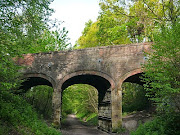The High Weald
 |
Link to GPX File of Route The High Weald
This is a 43 mile route through the High Weald ‘Area of Outstanding Natural Beauty’ from Crawley to the outskirts of Eastbourne, which might appeal to anyone who wants an off road trail that doesn’t involve the very rough tracks beloved of the mountain bikers. It follows National Cycle Route 21, so mapping it involved very little effort on my part,. I have eschewed waypoints simply because I am ignorant of any compelling things to look out for on the route. The attraction is simply the generously wooded countryside; ‘Weald’ comes from the old German word ‘Wald’ and means ‘Wooded’.
But the ‘High’ in the name isn’t a misnomer and there are a few climbs between miles 21 and 31 as you head south, before a gentle cruise down from the Weald towards the coast on the ‘Cuckoo Trail’ towards Polegate Station. This is one of the many trails built on railway lines cut by Beeching in the 1960's and I believe it ran from Polegate to Tunbridge Wells. Apparently they used to release a cuckoo every year at Heathfield Fare which they fancifully claimed to be the first cuckoo of spring, hence the name.
If you want to go beyond that into Eastbourne, for dinner on the seafront perhaps, you have another five miles to go.
 |
| Cuckoo Trail |
Like all of South East England, the clay and sandstone rocks of the Weald were formed from sediments of muck at the bottom of the sea. They emerged from the water about 60m years ago, only be concertinaed by movements in the Earths Crust. The Weald was an anticline or upwards fold which, having poked its rocky head over the parapet, was carved up by river valleys and eroded away. (The syncline or downward fold to the north became the Thames Basin).
The area now is an 'Area of Outstanding Natural Beauty' (AONB), described in their website as “a medieval landscape of wooded, rolling hills studded with sandstone outcrops; small, irregular-shaped fields; scattered farmsteads; and ancient routeways”. See the link below.
The High Weald remained heavily wooded for centuries and was only thinly settled until recently. Now, this is no pickled Arcadia but one of the most densely populated of Britain’s areas of protected countryside and part of the penumbra of the Great Wen. The route actually feels more remote than it is; the trees hide a lot and the path threads its way like a sly ghost through the towns but looking around you will also see more than the odd glimpse of the serried rows of Semis, saloons and salons of London’s diaspora. But it is still lovely for all that and if you look carefully and know what you are looking for, you will see the faint and flickering legacies of old boundary ditches, holloways and hedges, the latter all grown up into woodland and sometimes coppiced



Comments
Post a Comment
You can leave a message here or email me :
mail@mickbeaman.co.uk